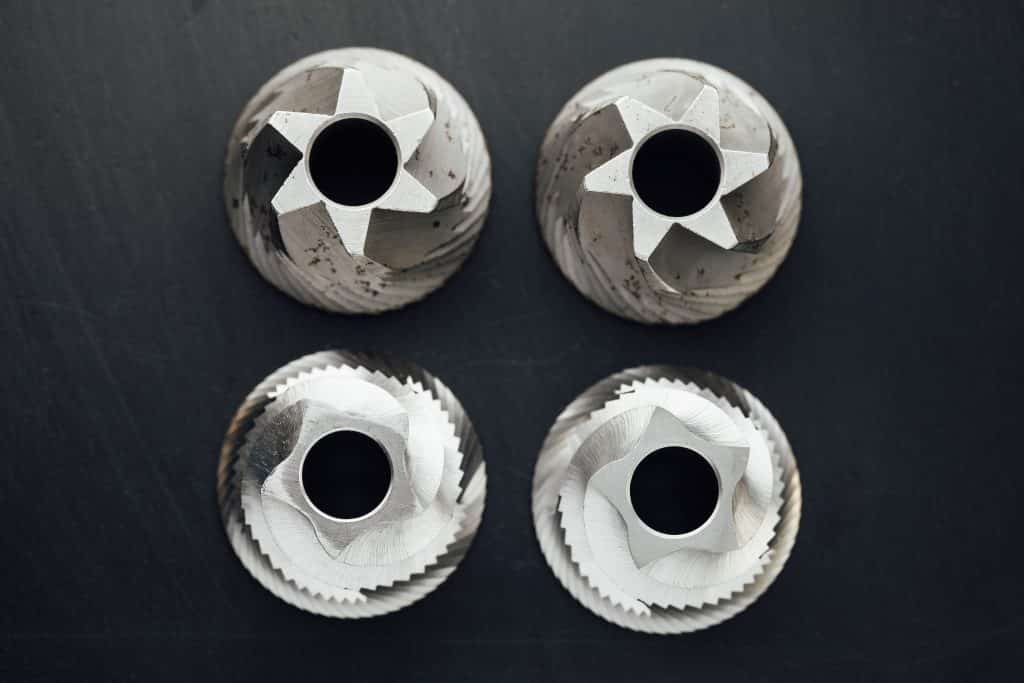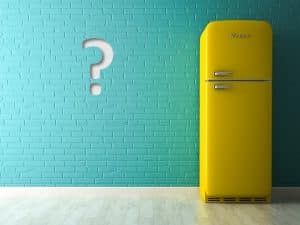
Is coffee technically a tea? Answered By Monsieur Coffee
I had a discussion with a friend the other day. He stated that coffee is actually a tea. I was dumbstruck. How can you say
Anyone serious about coffee knows that grinding your own coffee beans is one of the best things you can do to improve the quality of the coffee you make. But, if you own a burr grinder, you might wonder if those burrs ever need replacement.
So, do the burrs in coffee bean grinders ever wear out? The answer: Yes, burrs in coffee bean grinders do wear out. But if you own a good quality grinder, the burrs will probably last a long time. As a rule of thumb: steel burrs need replacement after grinding 1000 lbs (or approximately 450 kilograms) of coffee beans. Ceramic burrs need replacement after grinding 750 lbs (or about 340 kilograms) of coffee beans.
That’s a lot of coffee! Depending on the brew method, your steel burrs should be able to handle enough coffee for approximately 56,000 shots of espresso or 21,000 mugs of pour-over coffee. Your ceramic burr grinders wear out a bit faster, but can still grind enough coffee for approximately 42,500 shots of espresso or 16,000 mugs of pour-over coffee. Wow!
But there is more to it.

There are four types of coffee bean grinders. There are blade grinders, manual burr grinders, and automatic burr grinders with either flat or conical shaped burrs.
The blade grinder, also known as the spice grinder, is a device with a set of blades in it. These blades spin at high speeds to blast everything on the chamber into small pieces. These grinders are cheap, but they are not ideal for grinding coffee beans. The blades smash the beans to pieces without control. You’ll end up with a very inconsistent pile of ground coffee. A lot of larger chunks and some very fine dust. An inconsistent grind leads to an inconsistent extraction. The larger pieces will under-extract, the smaller will over-extract. This leads to many problems with acidity and bitterness in your final brew.
Then there are burr grinders. Burrs have to piece which grind the coffee beans in between them. The space the burrs are set apart determines the grind size. A good burr grinder will produce a very consistent batch of ground coffee. Burr grinders come in either manual or automatic form. Manual coffee grinders are operated by turning a crank, which sets the top burr in motion. This feeds the beans in between the burrs and grinds them. An automatic burr grinder does the same but at the push of a button. Some come with a set of flat disc burrs, others with conical shaped burrs.
Flat disc burrs that do a good job are usually only found in very high-end coffee bean grinders for professional coffee shops. Home grinders are generally better off with conical shaped burrs. Less expensive coffee bean grinders (those for home use) with flat disc burrs are just not that good.
Most available burr grinders come with either ceramic or steel burrs. There is a difference between the two, but for home use, this is not something you need to worry about too much. The two key differences have to do with heat and sharpness.
Ceramic burrs retain less heat than steel burrs. While operating a grinder, heat is generated due to the moving parts rubbing together (burrs and coffee beans). Too much heat can burn off some of the oils that are naturally in the coffee bean. These oils are one of the compounds that determine the flavor of the coffee, so you want to lose as little of it as possible.
Ceramic burrs also keep their edge for longer.
Contrary to what you may think grinding is all about, the burrs in your coffee bean grinder are supposed to cut your beans into small pieces. Sure, some breaking and mashing is going on when the coffee beans are forced between the burrs, but the actual breaking up of the bean should happen by it being cut by the sharp edges on the burrs.
Therefore the edges on the burrs must be sharp. Dull burr edges cannot cut the bean, and grinding will be the result of breaking and mashing beans through the space between the burrs. This will result in a grind that is much less even. Sharp edges cut the beans to pieces that are the size of the space between the burrs. The result is an even and consistent grind.
Evenly sized ground coffee results in an even extraction of flavors during the brewing process. This is important because over-extraction and under-extraction produce off-flavors. These off-flavors will make your coffee overly bitter of too acidic.
When you suspect your burrs are getting dull, it is time to find out whether this is true. It would be a shame to buy a set of new burrs if you don’t need to. A set of replacement burrs for the popular Baratza coffee bean grinders will set you back between $29 and $60 at the time of writing. Having Baratza replace your burrs would even cost you between $74 and $150! You better make sure your burrs are the problem!
Lorem ipsum dolor sit amet, consectetur adipiscing elit. Ut elit tellus, luctus nec ullamcorper mattis, pulvinar dapibus leo.
This one is probably a bit obvious. Take out your burrs, clean them, and feel whether the edges are still reasonably sharp. If you remember how they felt when they were brand new, great! You’ll be able to tell the difference. But in any case, you should be able to feel whether to burrs are dull. They need to be able to cut. If they feel smooth even, it is time to replace them.
Dull burrs cannot grind with as much precision as sharp burrs. The dulling of the burrs leads to a coarser grind on the same grind setting over time. If you feel you have to keep adjusting the settings on your grinder to get the desired grind size, they are probably getting dull.
When the edges on a burr become dull, there is less cutting and more mashing. The machine (or your arm) works the beans in between the burrs, but instead of cutting them into the desired grind size, the beans are mashed and pulverized between the burrs. This inevitably leads to a more inconsistent grind. If you start to find a lot of large pieces of ground coffee and extra fines in the ground coffee, your burrs are dull.
And as said, an inconsistent grind leads to off-flavors in the final product. In short: sharp burrs are necessary for a consistent grind, which is necessary for a cup of coffee that is not overly bitter or acidic.
This one is only applicable if you are grinding at a very fine setting. Mainly for espresso but also for brews like Turkish coffee. When your blades start to dull, the grinder won’t be able to disperse the ground coffee evenly. You’ll end up with little clumps of ground coffee in the container. You can easily break these up with a spoon or your finger, and they won’t impact the flavor of your coffee at all. But, it is a sign that the edges on you burrs are getting dull.
This one is a bit obvious, but it can help. If your grinder has processed more than 1000 pounds (450 kilograms) of coffee beans, there is a good chance the edges on the burr are at least a bit dull.
Of course, no one keeps track of the amount of coffee they grind for years. But there is an excellent way to get an idea of how much coffee your grinder processed until now.
Bear with me.
First, think of the amount of coffee you buy. Do you buy coffee bags of 1 lb or 2 lbs? Or maybe by the kilogram or 500 grams.
Then, think about how long a bag of coffee beans typically lasts. A couple of days, a week, a month (surely not!)
Next, figure out how long you have had your current coffee bean grinder.
And finally, reverse engineer the approximate number of lbs or kilograms of coffee beans your grinder has processed.
An example:
Let’s say I go through 1 lb of coffee beans a week. And, let’s say I still have the receipt, and I know for a fact that I bought my current grinder precisely 5 years ago. Ok, now break out the math:
1 lb per week is 1 lb * 52 weeks in a year = 52 lbs per year
5 years of owning the grinder * 52 lbs per year = 260 lbs total
I like to add 10% of my yearly coffee bean consumption per year to this total to account for parties, birthdays, and all-nighters. So:
260 + 260*0.1 = 286 lbs of coffee beans
This means I am far from the 750 to 1000 lbs my grinder should be able to handle.
Knowing when the burrs on your coffee bean grinder are dull is great. But keeping them in good shape is even better. You still have to look out for dull burrs, but maintaining them properly guarantees they stay sharp for as long as possible.
As you grind your coffee beans, oils, and small coffee beans, dust stays behind on the burrs. These not only impact the grinding capability of your grinder, they might also have a negative impact on your coffee. Cleaning them, therefore, serves a dual purpose. It keeps your coffee tasting as it should, and it keeps the burrs in your grinder in good condition.
How to clean your coffee bean grinder
The first step is to disassemble the grinder. If you have a simple manual coffee grinder, you can usually fully disassemble it without any problems. If you own an automatic coffee bean grinder, refer to your user manual for instructions on how to disassemble and clean it.
The bigger parts of the coffee grinder, e.g., the hopper and the container for the ground coffee are best rinsed with hot water and a mild detergent like dishwashing soap. The burrs themselves require a more careful approach. It is best not to submerge them in water to soak. My preferred method is to take a Q tip, dip it in a mixture of hot water and dish soap. Use the wet Q tip to clean the burrs and give them a quick rinse afterward.
Dry every part well before reassembling the grinder.
There are some great resources on cleaning your coffee grinder out there. I am a big fan of the very helpful videos Seattle Coffee Gear has on coffee gear maintenance in their “Morning Maintenance” series. They have a few videos on cleaning some of the more popular automatic coffee grinders (a Breville, Baratza, and Rancilio grinder), and one discussing the cleaning of a manual coffee bean grinder (the Hario Skerton).
Check them out below:
I hope this article answered all your questions regarding the lifespan of burrs in coffee bean grinders, hot to find out whether they are dull, and how to properly maintain them (and the rest of your grinder).
If you happen to be looking for a good coffee bean grinder, please consider checking out our round-up of the best manual coffee grinders and the best automatic coffee grinders.
Have a great day!
MonsieurCoffee.com is a participant in the Amazon Services LLC Associates Program, an affiliate advertising program designed to provide a means for sites to earn advertising fees by advertising and linking to Amazon.com. We earn small commissions on purchase made through links on this site, at no extra costs to you.

I had a discussion with a friend the other day. He stated that coffee is actually a tea. I was dumbstruck. How can you say

During hot summer days, there is a good chance you like your coffee iced. For this and for all your other favorite cold coffee drinks,

So you have brewed the perfect batch of coffee with your Chemex coffee maker. But, it is too much to fit in one cup. How

Caffè sospeso, or suspended coffee, is a tradition originating in Naples, Italy. Customers in the local coffee bars drink their morning espresso (one) and pay